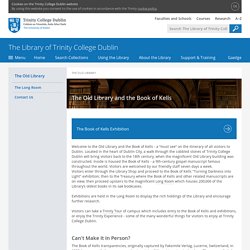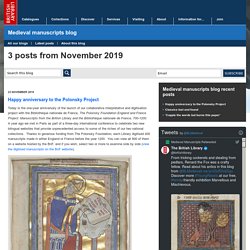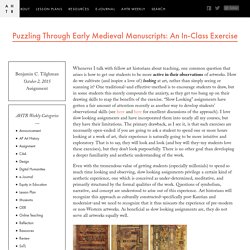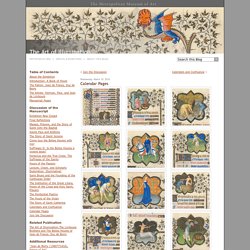

Twitter. Twitter. How Illuminated Medieval Manuscripts Were Made: A Step-by-Step Look at this Beautiful, Centuries-Old Craft. What place does the paper book have in our increasingly all-digital present?

While some utilitarian arguments once marshaled in its favor ("You can read them in the bathtub" and the like) have fallen into disuse, other, more aesthetically focused arguments have arisen: that a work in print, for example, can achieve a state of beauty as an object in and of itself, the way a file on a laptop, phone, or reader never can. The Old Library - The Library of Trinity College Dublin - Trinity College Dublin. The Book of Kells Exhibition Welcome to the Old Library and the Book of Kells - a “must see” on the itinerary of all visitors to Dublin.

Located in the heart of Dublin City, a walk through the cobbled stones of Trinity College Dublin will bring visitors back to the 18th century, when the magnificent Old Library building was constructed. Inside is housed the Book of Kells - a 9th-century gospel manuscript famous throughout the world. Visitors are welcomed by our friendly staff seven days a week. Digitised Manuscripts. Content Contents:Fourteen episodes of the French verse romance, Le Roman de Renart (Reynard the Fox), attributed to Pierre de Saint Cloud, Richard of Lison and others.

The Roman is based on a large collection of tales from Oriental sources, mostly collected and translated in Picardy or the Paris area in the 12th and 13th centuries. The codex has been incorrectly bound. The text begins at the current f. 11 (numbered 'xix' on the verso) and the first 8 leaves in the current volume (ff. 3-11) should follow f. 36. Medieval manuscripts blog: November 2019. So wrote Henry Howard, Earl of Northampton to his friend and confidante, the antiquary Sir Robert Cotton, in 1606.

The letter appears (at f. 160r) in a wide-ranging volume of Northampton’s letters and papers covering the period from 1567 until his death in 1614 (Cotton MS Titus C VI, from which all references following come). Northampton's letter to Robert Cotton: Cotton MS Titus C VI, f. 160r It is always fascinating to historians when letters survive which the recipient was supposed to burn: what indiscreet or seditious words might be revealed? So it at first sight odd that this seems to be about an author objecting to somebody changing the title of a book. Puzzling Through Early Medieval Manuscripts: An In-Class Exercise. Whenever I talk with fellow art historians about teaching, one common question that arises is how to get our students to be more active in their observations of artworks.

How do we cultivate (and inspire a love of) looking at art, rather than simply seeing or scanning it? One traditional–and effective–method is to encourage students to draw, but in some students this merely compounds the anxiety, as they get too hung up on their drawing skills to reap the benefits of the exercise. “Slow Looking” assignments have gotten a fair amount of attention recently as another way to develop students’ observational skills (see here and here for excellent discussions of the approach). I love slow looking assignments and have incorporated them into nearly all my courses, but they have their limitations.
[editors note: The images in the post correspond to those in the PDF uploaded in the hypertext below.] This exercise serves to structure a looking experience more appropriate to its art. Prep: The Art of Illumination: The Limbourg Brothers and the Belles Heures of Jean de France, Duc de Berry. Wednesday, June 16, 2010 Exhibition Now Closed Above: Details of illuminations from Folio 6r, Folio 8r, and Folio 10r from the Belles Heures of Jean de France, duc de Berry, 1405–1408/9.

Herman, Paul, and Jean de Limbourg (Franco-Netherlandish, active in France by 1399–1416). French; Made in Paris. Ink, tempera, and gold leaf on vellum; 9 3/8 x 6 5/8 in. (23.8 x 16.8 cm). The Art of Illumination. Nearly all books of hours began with a section of calendar pages, to help the owner keep track of saints’ days and holidays throughout the year.

Local variants in the veneration of saints, combined with the personal tastes of individual patrons, make calendar pages a rich resource for scholars seeking to localize a manuscript. Hypertext Book of Hours, Home Page. The Medieval Masterpiece, the Book of Kells, Is Now Digitized & Put Online. If you know nothing else about medieval European illuminated manuscripts, you surely know the Book of Kells.

“One of Ireland’s greatest cultural treasures” comments Medievalists.net, “it is set apart from other manuscripts of the same period by the quality of its artwork and the sheer number of illustrations that run throughout the 680 pages of the book.” The work not only attracts scholars, but almost a million visitors to Dublin every year. “You simply can’t travel to the capital of Ireland,” writes Book Riot’s Erika Harlitz-Kern, “without the Book of Kells being mentioned. And rightfully so.”